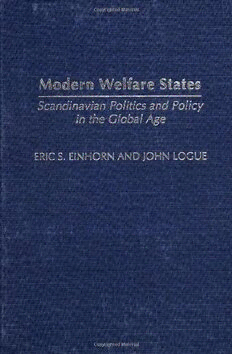
Modern Welfare States: Scandinavian Politics and Policy in the Global Age PDF
Preview Modern Welfare States: Scandinavian Politics and Policy in the Global Age
Modern Welfare States Modern Welfare States Scandinavian Politics and Policy in the Global Age Second Edition ERIC S. EINHORN AND JOHN LOGUE LibraryofCongressCataloging-in-PublicationData Einhorn,EricS. Modernwelfarestates:Scandinavianpoliticsandpolicyintheglobalage/EricS. EinhornandJohnLogue.—2nded. p. cm. Includesbibliographicalreferencesandindex. ISBN0–275–95044–1(alk.paper)—ISBN0–275–95058–1(pbk.:alk.paper) 1.Scandinavia—Politicsandgovernment—1945– 2.Scandinavia—Socialpolicy. 3.Welfarestate. I.Logue,John,1947– II.Title. JN7042.E45 2003 361.948—dc21 2002029882 BritishLibraryCataloguinginPublicationDataisavailable. Copyright(cid:1)2003byEricS.EinhornandJohnLogue Allrightsreserved.Noportionofthisbookmaybe reproduced,byanyprocessortechnique,withoutthe expresswrittenconsentofthepublisher. LibraryofCongressCatalogCardNumber:2002029882 ISBN:0–275–95044–1 0–275–95058–1 Firstpublishedin2003 PraegerPublishers,88PostRoadWest,Westport,CT06881 AnimprintofGreenwoodPublishingGroup,Inc. www.praeger.com PrintedintheUnitedStatesofAmerica Thepaperusedinthisbookcomplieswiththe PermanentPaperStandardissuedbytheNational InformationStandardsOrganization(Z39.48–1984). 10 9 8 7 6 5 4 3 2 CopyrightAcknowledgments Theauthorsandpublishergratefullyacknowledgepermissiontoreprintthefollowing: Excerptsfrom“OfMaastricht,SocialDemocraticDilemmas,andLinearCucumbers,”John Logue,ScandinavianStudies64(4):626–40.1992.Reproducedwithpermission. Excerptsfrom“RestrainingtheGovernors:TheNordicExperiencewithLimitingthe StrongState,”JohnLogueandEricS.Einhorn,ScandinavianPoliticalStudies11(1):45–67. 1988.Reproducedwithpermission. Excerptsfrom“TheScandinavianDemocraticModel,”EricS.EinhornandJohnLogue, ScandinavianPoliticalStudies9(3):193–208.1986.Reproducedwithpermission. Contents Illustrations vii Preface:ScandinaviaintheEraofGlobalization ix Acknowledgments xv AbbreviationsandAcronyms xvii I. UnderstandingScandinavianPolitics 1 1. StilltheSocialLaboratory? 3 2. ThePerilsofSuccess 15 II. ScandinavianDemocracyToday 35 3. IsThereaScandinavianDemocraticModel? 37 4. InstitutionsofDemocracy 53 5. PoliticalActors:Parties,Voters,InterestGroups 93 III. ScandinavianWelfareStates 145 6. ThePoliticsofSolidarity 147 7. PolicyinanInterdependentWorld 163 8. TheSocialWelfareState 191 9. ManagingtheMarketEconomy 219 10. FromIndustrialConflicttoWorkplaceDemocracy 259 vi Contents IV. TheModelAppraised 303 11. ScandinavianWelfareStatesandTheirCritics 305 12. TheFutureoftheScandinavianModel 325 V. Appendixes 351 A. PopularVoteinScandinavianParliamentaryElections 353 B. DistributionofParliamentarySeats 360 C. GoverningPartiesandCoalitions 366 D. ElectionstotheEuropeanParliament,1979–99 376 References 379 Index 395 Illustrations FIGURES 1.1 MapofScandinavia 6 5.1 ScandinavianPartyCoalitions,1930s–1950s 118 5.2 ScandinavianPartyCoalitions,1960s–1980s 119 5.3 ScandinavianPartyCoalitions,1990stopresent 122 10.1 TheDevelopmentofScandinavianIndustrialRelations 266 10.2 HowtheSolidaristicWagePolicyWorks 282 TABLES 1.1 Scandinavia’sGeography,Demography,andEconomy 5 3.1 DevelopmentofPoliticalDemocracyinScandinavia 39 4.1 IncreaseinWomen’sRepresentationinParliament,1960–2000 71 4.2 ParliamentaryBasesofGovernmentSupportasPercentof Years,June1945–April2003 74 4.3 EuropeanCommunity/UnionReferendainScandinavia, 1972–2000 86 4.4 LocalandCountyGovernment,1999 89 5.1 ScandinavianPartySystems:MajorPartiesContestingthe 1998–2003ElectionsbyIdeologicalPlacement 98 viii Illustrations 5.2 SwedishPartyVote(Percent)byOccupationofVoters,1998 128 6.1 TheOriginsofSocialInsurance:DateofPassageofFirst ComprehensiveSocialLegislation,byTypeofLegislation 149 7.1 ImmigrationandRefugeesinScandinavia,1990–2000 176 8.1 PublicSocialExpenditureTransfers,asaPercentageofGDP, 1960–99(averageforperiod) 201 8.2 ScandinavianSocialWelfarePrograms 203 8.3 SocialSecurityExpendituresbyPurposeintheNordic Countries,1998 204 8.4 IncomeDistributionandPoverty 210 8.5 GrossandNetSocialExpendituresasaPercentageofGDP atFactorPrices,1997 211 9.1 RealGDPGrowthperCapitaandInflation,AverageAnnual Rates,1960–2002 221 9.2 LaborForceasPercentageofPopulationAged15to64,by Gender,1960–99(averageforperiod) 230 9.3 ReceiptsandOutlaysofGovernmentasPercentageofGDP, 1960–99 246 9.4 SpendingonUnemploymentPolicies,asPercentageofGDP, 1985–96 248 9.5 SourcesofTaxRevenuesasaPercentageofTotalTax Revenue,1998 251 10.1 Trade-UnionDensityinSelectedWesternNations,1950–97 263 10.2 DaysLostthroughStrikesandLockoutsper1,000Employees inSelectedWesternNations,1960–99 281 Preface: Scandinavia in the Era of Globalization “A week is a long time in politics” is the way British Prime Minister HaroldWilsononceputit. Adecadeisevenlonger.ReviewingourearliereditionofModernWelfare States, which appeared in 1989, we were impressed by how much had changedinthesefewyears.ThecollapseoftheSovietUnionandtheend of the Cold War fundamentally altered the balance of power in Scandi- navia, permitting both Finland and Sweden to join the European Union. ImmigrationhasincreasinglyturnedtheoncehomogeneousScandinavian states into societies of racial, religious, ethnic, and linguistic diversity— and put the issue of civil rights for immigrants on the political agenda. Privatization has become fashionable, even for some of the Social Dem- ocrats who once sawthe growth ofthe publicsector as thesurrogatefor socialism. The Scandinavian Social Democratic model offered capitalism with a humanface:aredistributivewelfarestatethateliminatedpovertyandthat wasbasedonaprivatelyowned,marketeconomy.Transferpaymentsand socialservicesraisedthelivingstandardsoftheworstofftonearmiddle- classlevels.Thetaxburdenwashigh,butcarefulnationaleconomicman- agement limited the costs of countercyclical public sector spending. The toolsofstatepowerwereusedtopromotepolitical,social,andeconomic egalitarianism. There were plenty of strains, but those strains were pri- marilyinternaltotheindividualScandinavianstate’ssystem. Thismodelwaspremisedontheassumptionthatthenation-stateisthe proper unit for making economic policy. In the increasingly globalized economy,thissimplyisnolongertrue.Everyyearpowerseepsfromthe x Preface:ScandinaviaintheEraofGlobalization ScandinaviacapitalsofCopenhagen,Helsinki,Reykjavik,Oslo,andStock- holm to the European Commission in Brussels, to the European Central BankinFrankfurt,totheinternationalcommercialbanksinLondon,New York, and Tokyo, and to multinational corporations in England, France, Germany, Holland, Japan, and the United States. This has profound im- plications for the future development of the Scandinavian Social Demo- craticmodel. Much in Scandinavia and in this book is still the same as it was more than a decade ago. The political history of modern Scandinavia is un- changed, although a bit longer. Political institutions are little changed, although they deal with new policy issues and have an overlay of Euro- pean Union law. Political actors—parties, interest groups—are funda- mentally the same, although they too grapple with new problems. Scandinavian trade unions have actually increased their already strong position, while trade unions elsewhere in the world have lost member- ship. The Social Democrats have been almost as dominant in govern- mentalofficeastheywereintheirheyday. Much,however,haschanged.Amongpoliticiansandvoters,anewgen- eration has come of political age, solidifying party fragmentation. The monolithic Social Democratic vote from working-class families has de- clined as the working class has become more affluent and as the wedge issueofimmigrationhasunderminedpoliticalclasscohesion;partymem- bership has plummeted to half or less of what it was a dozen years ago. Womenhavecomeofageinpolitics,providing40ormorepercentofthe members of parliament, a prime minister in Norway, a president in Ice- land, both president and prime minister in Finland, and the chair of the Swedishtradeunionfederation. The first edition of Modern Welfare States dealt with two major policy themes.ThefirstwasthedevelopmentofthemodernScandinavianwel- farestateintheperiodbetweenwhenSocialDemocratstookpowerinthe depths of the Great Depression and the oil crisis in 1973–74. The second dealt with the internally generated strains that came to the fore in the 1970sand1980s.ThetaxrevoltledbyMogensGlistrupinDenmarkand AndersLangeinNorway;theperniciousinterplaybetweenhighmarginal taxrates,highinterestrates,andthetaxdeductibilityofmortgageinterest ontheeconomy;andeffortstoreformthetaxsystemtoavoidtheseprob- lemsfiguredheavily.Sodidrisingtake-upratesforvariouswelfarestate servicesamongtheyoungergeneration.Althoughtaxesandwelfarepro- gram take-up rates remain issues, tax reforms and welfare adjustments haveamelioratedsomeofthedifficulties. WedepictedaScandinaviasubstantiallyaheadoftherestofEuropein terms of its provision of transfer payments and social services to its citi- zens, a region that was more egalitarian than the Continent or England, wheredemocracywasasocialandeconomicconceptaswellasapolitical
